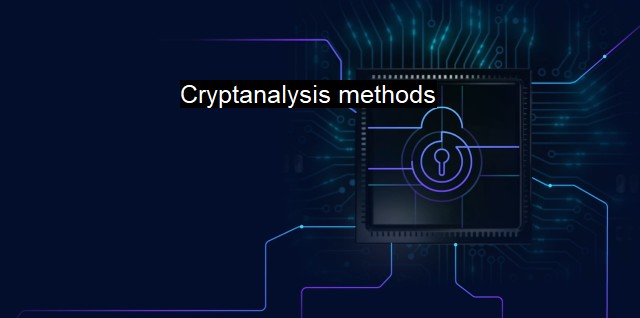What are Cryptanalysis methods?
Exploring Cryptanalysis Methods: The Importance of Encryption Analysis in Ensuring Cybersecurity and Antivirus Protection
Cryptanalysis methods are techniques utilized in cybersecurity to decipher or decode cryptographic systems. Cryptography is the science of protecting information by transforming it into an unreadable format. Cryptanalysis, conversely, is the art of deciphering encoded data back into its original format without information about the original encryption.Password Storing
One of the fundamental areas where cryptanalysis is employed is in the storage of data, such as passwords. When you input your password in an application, what's typically stored is not the password itself, but its hash value. Hashing is a method where data is converted into a unique fixed-length string, which is the hash value. This method provides for any attempts at direct access to the document or password to yield only the hash value and not the text.
Ciphertext Analysis
Ciphertext-only analysis is the basis of all decryption and without the correct key to decrypt, the process could take longer and become highly complex. It involves examining patterns and frequency of certain symbols and making educated estimations. The goal of the analysis is to deduce the plaintext from the patterns and frequency of ciphertext.
Known / Chosen Plaintext Attacks
Known plaintext attack is another cryptanalysis method where the analyst has access to both the plaintext and its encrypted version. By analyzing both bits of data, they can identify patterns and relationships which help decipher other portions of cryptic text. in a chosen plaintext attack, an attacker selects a section of plaintext and analyzes the corresponding ciphertext, a capitalizing tactic for exploratory attacks meant to uncover encryption weaknesses.
Side-Channel Attacks
Side-channel attacks constitute a unique method of encryption break-down. They primarily rely on information gathered from the physical implementation of the cryptographic system rather than the brunt force approach of hash breaking, for example. Metrics like timing information, energy consumption, or even sound can provide valuable insights to corporate hackers. Advanced firewalls and antivirus software constantly monitor for abnormal patterns to prevent such intrusions.
Differential and Linear Cryptanalysis
Differential and linear cryptanalysis are complex strategies designed to attack symmetric key cyphers. Differential cryptanalysis involves studying the differences between two plaintexts and their corresponding ciphertexts, as a way to reveal the structure of the key. Linear cryptanalysis, on the other hand, studies the key-based linear approximation of how plaintext is transformed into ciphertext. Both methods are often used for reverse-engineering cryptographic algorithms, but they are mostly obsolete since modern encryption exceeds their capacities.
Social Engineering
Last but not least, there's an often-overlooked part of cryptanalysis: social engineering. While not a technical method, it's a practice where fraudsters endeavour to manipulate people into giving up confidential information. It shows that even the most formidable encryption system cannot protect data if humans can be persuaded, tricked or intimidated into simply giving it away.
Cryptanalysis is a field in cybersecurity that attempts at revealing enough information to make cracking encrypted codes feasible. As technology advances, the opposing world of cybersecurity have to continuously stay steps ahead in order to keep data safe. Hence, being informed about cryptanalysis can dramatically help improve both an individual's and an organization's safety concerning confidential data. Also, antivirus software must consistently be updated and patterns foreseen to push back against growing threats because cryptanalysis operates in an evolving cybersecurity arena.

Cryptanalysis methods FAQs
What is cryptanalysis and how does it relate to cybersecurity?
Cryptanalysis is the study of cryptographic systems with the aim of identifying weaknesses and vulnerabilities that can be exploited to gain unauthorized access to the system or information. In the context of cybersecurity, cryptanalysis is used to develop and implement effective security measures to protect information and systems from attacks by hackers and other unauthorized individuals.What are some commonly used cryptanalysis methods?
Some of the commonly used cryptanalysis methods include frequency analysis, brute-force attacks, known plaintext attacks, and chosen ciphertext attacks. These methods are designed to take advantage of weaknesses in cryptographic systems to gain unauthorized access to the information they protect.What is the difference between symmetric and asymmetric cryptanalysis methods?
Symmetric cryptanalysis methods use the same key for encryption and decryption, while asymmetric cryptanalysis methods use different keys for encryption and decryption. Symmetric methods are generally faster than asymmetric methods but are less secure, while asymmetric methods are more secure but have slower processing speeds.How can antivirus software use cryptanalysis to detect and prevent cyber attacks?
Antivirus software uses cryptanalysis to identify and analyze patterns in malware code to detect and prevent cyber attacks. By analyzing the code used by hackers to create malware, antivirus software can identify vulnerabilities and develop effective countermeasures to prevent attacks. Cryptanalysis is also used to develop and implement encryption algorithms and other security measures to protect against cyber attacks.| | A | | | B | | | C | | | D | | | E | | | F | | | G | | | H | | | I | | | J | | | K | | | L | | | M | |
| | N | | | O | | | P | | | Q | | | R | | | S | | | T | | | U | | | V | | | W | | | X | | | Y | | | Z | |
| | 1 | | | 2 | | | 3 | | | 4 | | | 7 | | | 8 | | |||||||